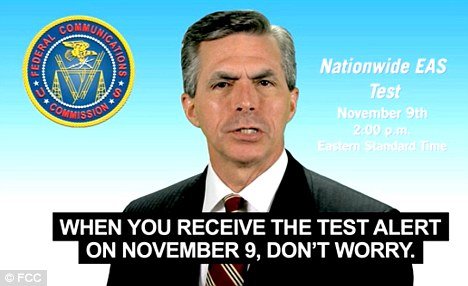
The Federal Emergency Management Agency (FEMA) and the Federal Communications Commission (FCC) remind American people not to panic when they lose television and radio service for a few minutes today at 2:00 p.m. during a test of the Emergency Alert System (EAS).
Although the public alert mechanism is decades old and often tested and used at the local level, it has never before been tested on a nationwide scale.
This first-ever test will occur at 2:00pm EST on Wednesday, November 9 and will occur simultaneously across the U.S. and its territories, lasting up to three-and-a-half-minutes.

The EAS is a national alert and warning system established to enable the President of the United States to address the American public during emergencies.
The National Oceanic and Atmospheric Administration (NOAA) National Weather Service, governors and state and local emergency authorities also use parts of the system to issue more localized emergency alerts.
EAS test will look and sound very similar to the local tests of the Emergency Alert System that occur frequently; the public will hear a message indicating that “This is a test” on broadcast radio and television stations, cable television, satellite radio and television services and wireline video service providers.
The disruption will occur across all states and the territories of Puerto Rico, the U.S. Virgin Islands and American Samoa.
FEMA and FCC sent an open letter to all stakeholders on Friday, including governors, federal legislators, broadcasters, news networks and other organisations, asking for their help in educating their respective communities about the event – to curb potential panic about lost communications services.
FEMA Administrator Craig Fugate and FCC Chairman Julius Genachowski wrote: “The various disasters our country has faced this year underscore the need for effective and well-tested emergency alert and warning systems that could be used in a time of real emergency, at a moment’s notice.
“The purpose of the test is to allow FEMA and the FCC to assess how well the Emergency Alert System would perform its primary function: alerting the public about a national emergency.”
The test is conducted to help identify any positive changes that could be made as FEMA, the FCC and other partners continue working to build “a modernized and fully accessible Emergency Alert System”, according to a press release issued by the organizations.
FCC and FEMA are also asking stakeholders to make sure their communities are aware of key facts about the test, including that the test .
The letter continued: “As with all of our work, we know that the support of our state, local, tribal and territorial partners, along with the private sector, our faith-based and disability communities, and other key stakeholders, will be vital to effectively raising the public’s awareness of the test and minimizing undue public concern.
“We greatly appreciate your continued partnership as we prepare for this unique event and important public service.”
EAS test will not impact landline or mobile phones, power grids, or internet connectivity.
What will happen during the EAS test:
* The test will be approximately 30 seconds long and will look and sound very similar to the frequent local tests of the Emergency Alert System
* It will be transmitted via television and radio stations within the U.S., including Alaska, Hawaii, the territories of Puerto Rico, the U.S. Virgin Islands and American Samoa
* An audio message will interrupt television and radio programming indication: ‘This is only a test,’ though text may not indicate this same message on the screen on every television channel
* Organisations that serve people with disabilities or people with limited English proficiency should be aware that they may receive requests for information or assistance from broadcasters or other communications service providers and emergency managers in the days leading up to, during, and after the test
* When the test is over, regular programming will resume
Source: The FCC
[youtube A3h7QVmGcn4]